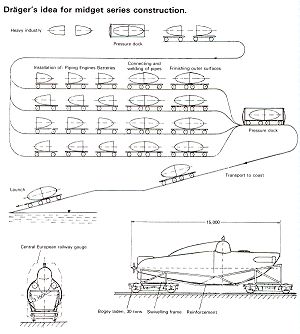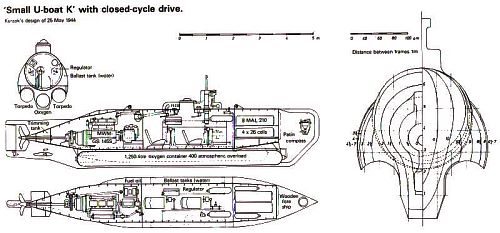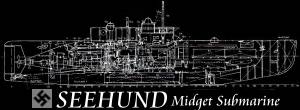|
Realized Midget
Submarines
Designs for small and midget U-boats had been rejected by the German
Navy, while available boats, especially Type VIIC, proved successful and
so long as the main tactical objective was the attacking of convoys. The
antipathy of the Navy towards very small U-boats was of very long
standing, going back to the origins of German submarine construction.
There had been no lack of suggestions as to their employment, and it had
been proposed that small or midget submarines be used as single units and
for hunting in packs from 'mother' ship.  A noted champion of the small
U-boat concept was Dr. Heinrich Dräager, the owner of Dräager-Werke,
Lübeck. A noted champion of the small
U-boat concept was Dr. Heinrich Dräager, the owner of Dräager-Werke,
Lübeck.
In a memorandum dated 1st October 1941, he presented a series of designs
for small U-boats of between 70 and 120 tons, with diesel-electric and
diesel closed cycle drive :
1) To build the required number of units, present warship construction
methods must be abandoned. Instead of building a complete boat, from keel
laying to launch, at one particular building slip on the coast, we must
adopt the production methods of aircraft, of tanks and of locomotives. The
sizes of boats and designs must be adopted for mass production of these
methods.
2) The construction of larger boats must be sub-divided (Cell
construction). It is necessary that the cells lend themselves to
transportation by rail, by road, by waterway, etc. so that pressure hull
construction and time consuming interior assembly can be carried out in
those place where, at any time, spare industrial capacity, both in terms
of personnel and construction installations are available in safe as
possible from air attack.
3) One estimates the following production times :
Pressure hull construction and cell - 14 to 20 working days
Interior assembly of cell - 30 working days
Welding together of cell and the remaining completion tasks -
30 working days
Including an additional period for transportation, Sundays
etc. we arrive at a period of 6 months from heat forming to slipway
launch, given uninterrupted working. After things have been in progress
for some time, some reduction of this time will probably be possible.
4) It is essential to try and achieve as accurate a uniformity of various
components in manufacture as possible, so that repair and yard times can
be a half of the usual times, through the quick and simple
interchangeability of components.
Thus, in 1941, he anticipated Merker's ideas on the section construction
of U-boats. Dr.Dräager went on to suggest the construction of Midget
U-boats of only 23 to 25 tons, which could carried to their operational
zone by surface vessels, or be used by auxiliary cruisers or
aircraft carriers for their own protection. Finally for the two most
important aspects of operation, he regarded the development of special
100-ton U-boats as feasible and for them to built in very large numbers
for the following purposes.
1) A U-boat for surface night attack, with a good surface shape and a
submerged propulsion as in general present use.
2) A U-boat for submerged attack, shaped like a torpedo and, if possible a
new type submerged propulsion to provide a high submerged speed.
In fact, test vessels for both types did exist at that time, but
Dr.Dräager knew nothing about them because of the secrecy surrounding
them. These were : 1) The so-called Engelmann High Speed Boat of 256 tons
which in its originally planned from, could not dive, and which was
unstable at high speeds, but which, with its low surface silhouette and
its strong diesel concentration, came very near to Dr.Dräager's
conception, and 2. The Walter test boat V80, which did, in fact, measure
up to requirements with regard to a high submerged speed and great
manoeuvrability, but which would not be suitable for operation of this
kind, because of its very noticeable wake of bubbles. However, Dräager's
ideas did not elicit any support from the Navy, or other ship construction
cycles and, on 22 January1942, he received a final rejection for his
U-boat suggestions from Counsellor of State Rudolf Blohm :
Even if the small U-boat can be brought to the point of fulfilling
technical requirements, we cannot regard it as adequate for operational
purposes because, carrying only 2 torpedoes, it has a minimal armament and
because, in adverse weather conditions, heavy seas do not allow small
vessels to be used adequately in operations. Furthermore , the radius of
operation, in the light of the increasing distances over which we are
having to wage war, is insufficient, concerning an increase in launching
of Types being currently constructed, capacity is totally dependent on
personnel and materials. As regards materials in providing power and fuel
supplies, bottlenecks in such areas as non-ferrous metal are highly
significant.
A small U-boat design was worked out in 'K' Office at the beginning of
1942, with a length of 25.33m and a displacement of 97.95 tons, but it did
not get beyond the project stage. One assumes that it had its origins in
the impression caused by the exaggerated reports of Japanese midget U-boat
successes during the attack on Pearl Harbor on 7 December 1941, and would
have had, as they did, a torpedo shaped hull. |
|
|
ype XXVII Midget U-Boat Hecht and Seehund
Not until the Autumn of 1943 was there a
change of opinion regarding the possible successful application of midget
submarines. On 23 September 1943, the British 30 ton boat X6 and X7,
succeeded in placing detonation charges under the battleship Tirpitz,
damaging her and putting her out of action for at least 6 months.
Subsequently , 'K' office worked out a design for a German two man U-boat
designated Type XXVIIA Hecht, which, like the British prototype, would
attach limpet mines to ships lying in otherwise safe anchorages. It was to
be considerably small, however, and in contrast to the X-class would reach
its target purely by submerged travel. Naturally the radius of action was
very restricted, and the boat would have to be carried to the vicinity of
the target by surface transport. In order to trim the floating boat, and
as it was anticipated that the boat would have to break thru nets,
adjustable weights on spindles were provided in place of hydroplanes. This
method, which harks back to Bauer's Brandtaucher, proved to be completely
unsuitable because conditions of considerably inclination these weights
could not be moved by hand quickly enough for them to be effective. Hecht
therefore, was given forward hydroplanes, with stabilizing fin aft, an
improvised measure that did not make for particularly good depth keeping.
With only submerged travel in mind, no diving tanks were provided. The
residual buoyancy of approximately 200 liters necessary before the crew
entered the boat was, in submerged travel, destroyed by the flooding of
the compensating tanks. The propulsion unit consisted of a 12 hp AEG
torpedo engine, whose revolutions were reduced by a V-belt drive. The
battery consisted of five 17T torpedo troughs, the plates of which were
replaced by stronger ones, so that the battery would have a greater
capacity and a longer life in conditions of low discharges. The
designation of this altered battery was 8 MAL 210. The largest
installation was a gyroscopic compass with a transformer, for it was
believe that this was indispensable for pure submerged travel.
When design work had been completed, the Chief of Naval War Staff made an
additional demand that this midget U-boat be able to carry torpedoes, so
that it could be used against moving targets in the immediate coastal
vicinity. As the volume of the boat was only 9.47 tons, only torpedoes
without negative buoyancy could be used, and these, lacking a battery
trough, had a restricted range. Hecht therefore had the choice of a mine
or a torpedo under its keel as armament. If she were being used for
torpedo carrying, a battery head with a further three battery troughs
could be installed : in practice, however her range of 69 nautical miles
at 4 knots was too small for this type of operation.
On 18 January 1944, Dönitz discussed with Hitler the plan for building 50
midget U-boats of this type. Hitler regarded it as good judgment to
develop this type for both mine and torpedo use and, on 9MArch 1944, GW
was given a contract for a prototype and, on 28 March, a contract for a
series of 52 boats. In April, it was decided to carry on building the
XXVII midget U-boats in large numbers.
Meanwhile "K" Office had produced numerous design under the Type
XXVIIB, which would have an increased range (a true U-boat propulsion
installation with diesel and electric motors) and a heavier armament (two
torpedoes). An initial design for which the HSVA
carried out shape research in June 1944, strongly resembled Hecht.
However, a fore-ship for surface travel had been added to the torpedo
shaped hull, and the keel had been enlarged to received battery troughs.
Saddle tanks were arranged close to the midships section. All this meant
that the surface displacement, without torpedoes, rose to 12.95 tons. A
small 22 hp diesel was provided for surface travel, and it was estimated
that this would provide a speed of 5.5 knots on the surface and 6.9 knots
submerged.
At about this time, the Supreme Naval Command's representative for close
cycle development at GW,
Chief Naval Construction Adviser Kurzak, Stimulated by the successful
closed cycle testing at the FKFS
of the two OM59/1 vehicle engines (each of 55 hp maximum performance), set
about designing a midget U-boat that could use this propulsion unit. It
was evident that the closed cycle drive in these small boats would have to
be much more efficient., a sentiment that Dr. Dräager had uttered as
early as 1941.
|
|

Kurzak's first Design - Small
U-Boat K
|
Chief Naval
Construction Adviser Kurzak's first design, involving a closed cycle drive
was "Small U-Boat K",
which had very little in common with Hecht. The boat's hull was suitable
for surface travel and had diving cell arranged on the sides, which partly
enclosed the torpedoes and replaced the torpedo attachments. This had the
effect of reducing somewhat the considerable submerged resistance of the under slung
torpedoes. The propulsion engine planned was the ship's 95 hp diesel
engine MWM-GS
145S, produced in large numbers by Süddeutschen Bremsen AG, Munich, and
used by the naval spare parts organization. It was expected in closed
cycle operation that this engine would supply a submerged top speed of
11-12 knots and a range of 70 nautical miles and, for long range travel at
a speed of 7 knots, a range of 150 nautical miles. Oxygen was to be stored
in a large pressure bottle containing 1,250 litres in the keel, and 4
accumulator troughs 8 MAL 210 were to be accommodated in the fore ship.
The boat was to have a length of 11.74 m and a submerged displacement of
13.8 tons.
The complete design for Small U-Boat K
was ready on 21 May 1944, and was discussed at a Supreme Naval Command
meeting chaired by the Commander of the Midget Weapons Units, Vizeadmiral
Heye, Chief Naval Construction Adviser Kurzak was requested to plan a
closed cycle installation appropriate to such a boat.
The shape of his design was to exert a considerable influence on the final
version of the small U-boat Type XXVIIB intended as the successor to
Hecht. Designated XXVIIB5 Seehund (Seal) later Type 127, a completely
finished midget U-boat evolved under the direction of Naval Construction
Adviser Grim, with a relatively powerful diesel-electric installation (60
hp Büssing lorry diesel and 25 hp AEG
electric motor), which had all the essential installation of a large
diving boat. Without exterior bunkers, the surface range amounted to 270
nautical miles at 7.7 knots and, with exterior bunkers, as much as 500
nautical miles at 7.7 knots, but this would have been rather much for the
crew in such a cramped boat. The battery capacity of 8 troughs of 7 MAL
210 (better capacity than the 8 MAL 210!) made possible a submerged voyage
of 63 nautical miles at 3 knots or 19 nautical miles at 6 knots. The
submerged properties of speed and range were not good, and this was
evident from the towing test at the HSVA
in July 1944. Without torpedoes in submerged travel, a Cw vaule of 73 was
measured; with torpedoes, it was only 59. From its very conception,
Seehund was rather more of a Semi-submersible with a very low surface
silhouette and superior diving qualities.
Initially, a profile rudder was intended for the lateral rudder, but the
turning circle was unsatisfactory. An improvement was subsequently
expected by using Kort nozzle rudder, but this was not realized. Finally,
a two surface rudder on one axle (box rudder) was tried out, and this did
improve the turning circle, but was liable to flutter.
The detailed planning of the 11.865m boat, which had a displacement of
12.3 tons, was handed over to the IBG,
with Naval Construction Director Dr. FIscher in charge, and Howaldt-Kiel
received a contract for 3 prototypes on 30 July 1944. Series construction
would subsequently be carried out at GW;
Schichau, Elbing; Klöckner-Humboldt-Deutz, Ulm, and at CRD-Monfalcone.
Most of the contracts and U-boat numbers had been awarded
by April 1944, even before the design of Seehund was completely ready.
|
Abbreviations
:
MWM : Motoren Werke
Mannheim
HSVA : Hamburgische Schiffbau Versuchsanstadt GmBH (Hamburg Shipbuilding
Test Institute)
FKFS : Forschungsinstitut für Kraftfahrwesen und Fahrzeugmotorenbau an
der TH Stuttgart
Research Institute
for Motor Transport and Motor Vehicle Engine Construction at the TH
Stuttgart.
AEG : Allgemeine Elektricitäts Gesellschaft
Cw : Official German Navy coefficient used to compare the form/propulsion
efficiency of boats.
GW : Germaniawerft, Kiel
IBG : Ingenierbüro Glückauf (Engineering Officer, Glückauf)
|
Are you arrive at this page through a
link from another site or search engine ? Click here to go to one35th main index page. |

